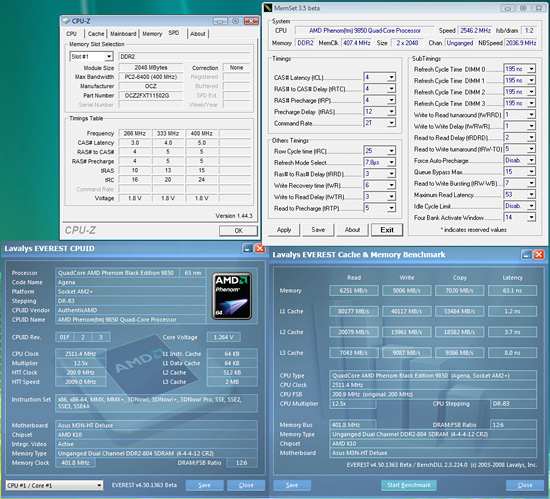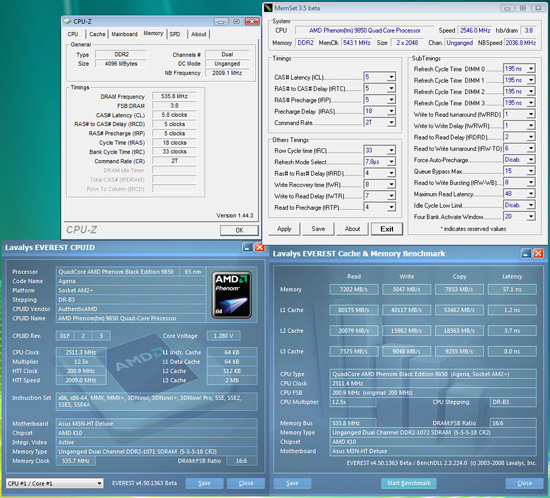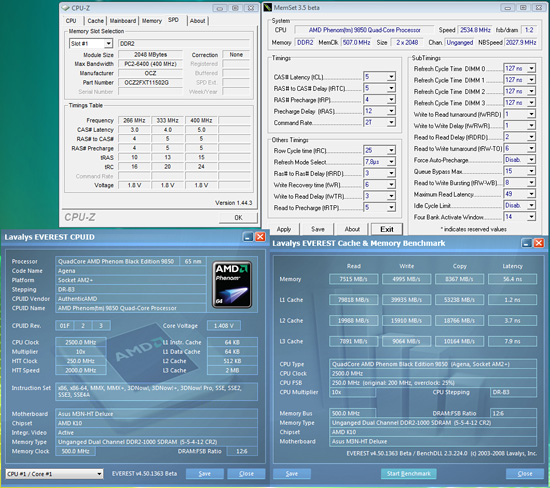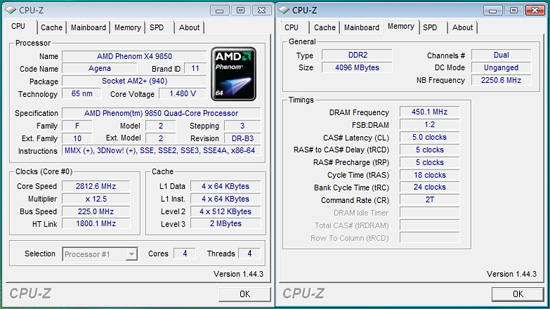NVIDIA 780a: Integrated Graphics and SLI in One
by Gary Key on May 6, 2008 12:00 AM EST- Posted in
- CPUs
Memory and Overclocking Performance
One of the most disappointing aspects of testing the ASUS M3N-HT Deluxe board was the general lack of compatibility with most of the 2GB modules at our disposal. The first few BIOS releases would rarely run a 2x2GB configuration in a stable manner and a 4x2GB setup was out of the question. The last BIOS release allowed us to complete our benchmarking sessions with a standard 4GB setup and 8GB was usable with one particular part from G.Skill. However, this board would lock immediately if you manually changed the settings for the onboard video memory from auto to a manual selection. The good news is that ASUS has replicated several of our problems and we expect a new BIOS release shortly for use in the motherboard review.
In the meantime, we are providing three test results with our memory at DDR2-800 and DDR2-1066 at stock processor settings along with a DDR2-1000 setting with an HTT overclock to 250 while retaining the same base CPU speed. DDR2-1066 operation was not always stable with 4GB or even 2GB for that matter, but we were able to complete our benchmark tests after relaxing several timings and increasing memory voltage from 2.0 to 2.1V. Overall, DDR2-1066 performance provided slightly improved latencies along with better read and copy throughput. Initial test results with several applications show a slight improvement of 1%~3% at stock CPU settings.
We wanted to show direct comparisons to the 790FX platform along with scaling and performance oriented timings, but the stability of the board with 4GB setups is just not to a point yet where we can guarantee 24/7 stability with performance oriented setups. We hope the BIOS updates from ASUS will address this quickly. Our initial testing with the MSI K9N2 Diamond board indicates this problem is strictly BIOS related as 4GB configurations are working well so far on this board.
Our most disappointing results with the board were during our overclocking tests. We constantly had to fight the 4GB memory problems and finally switched over to 2GB without much success either. This particular setup would only operate around 2.8GHz stable but required 1.48V and relaxed memory timings to reach this level.
Our particular CPU sample has done 3.3GHz at the same voltages on the 790FX platform. After discussions with NVIDIA and ASUS, the feel our current overclocking maladies are BIOS related at this time. We tend to believe them as manually setting the CPU voltage resulted in the board applying an additional 0.10V to the CPU. We noticed several other settings that would overvolt at various times but the CPU voltage was consistent and bothersome.
After a few days of trying to clock this board to meet the standards set by the 790FX platform, we decided to call it quits until the next BIOS release. One item worth mentioning is the BIOS design and options opened up by ASUS is nothing short of spectacular, especially in the memory timing section. We will go into more detail in the motherboard review, but if the memory, voltage, and OC problems are properly addressed, this should be one special board for Phenom overclockers.














38 Comments
View All Comments
SiliconDoc - Wednesday, May 7, 2008 - link
Maybe I'm the only one, but I'm so sick of every new PC component having a global warming psychotic power consumption "feature set", as if any of we end users actually give a d-a- you know what.Heck, maybe I'm lone gunman here, but it really makes me sick, over and over again, as if I'd buy their piece of crap because they have some wattage bean counter going gaga about their lower power requirements.
Hey, here's an idea. STOP GAMING, lower yer rezz, use a tiny 13 inch monitor, and put monitor sleep mode to kick on in one minute.
Better yet, shut your system off, you're wasting the earth, and get outside for heat from the sun or put on a wool sweater, or dunk ter head in the creek if you're too warm.
Who are they fooling ? They're pushing 1,000 watt PS's, then we have to hear this beanny watt counter crud. Yeah, right after the Q6600, 4 HD's, 2 DVD's, memory card readers, dual monitor outputs, ohhh.. and make sure you got a 700 watt plus supergigajiggawatt or she might not run.....
I for one would just like to say, to noone and nobody in particular, go take a green time out.
PS- this article is no more or less green than any other, so it isn't a target. I guess it's clear this is a power surge and perhaps an overload. Well, good!
Donkey2008 - Wednesday, May 7, 2008 - link
You are absolutely right, especially the application of this technology to notebooks, which is pure insanity. Why would I care if my laptop could switch from discrete to integrated GPU to save battery power and provide me another hour or so of use? I am trying to destroy the earth so I want as little battery life as possible so I can plug it in and use more resources.As for desktops, those crazy tree-huggers want you to use less power so that your systems run more efficient and PUT OUT LESS HEAT. This would be a complete waste for those who dropped several hundred dollars for water-cooling and giant, ridiculous, circus clown heatsinks. This isn't even mentioning the enviro-psychos who like to use their computer as a floor heater in winter.
How about you take your finger out of your nose because it is clearly in too far and blocking your brain from releasing any common sense.
SiliconDoc - Wednesday, May 7, 2008 - link
Why stop at that, you need the wind up power notebook, like the ones selling for the 3rd world. No plugging in and no charging any battery except by turning the crank handle.If you're gaming on a battery, it's not just your finger up your nose, but likely your neighbors as well, to hold it up so high. Where are you that you cannot plug in ... up in that airplane ... saving all that jet fuel ?... or did you drive your Yugo to some way out park to hack, away from civilization, also an energy saver, no doubt. Have fun disposing of the polluting battery, too.
Desktops: If your system is putting out so much heat that you need to run a refrigerator to "cool just the system down", you certainly are not "saving" any power either.. DUH.
Gigantic heatsinks (and their gargantuan fans)are power-hungry users trying to crank out the last bit of mhz, often with voltage increases, huh ... DUH. Maybe the jet engine they replaced was a cheap sleeve bearing, but they didn't "save power".
Not sure exactly what the donkey you were trying to say, since you didn't make any sense, but then, that's what it's all about, huh. Preening your green self while wildly flailing about and praising the gigantic power (savings ? lol ) drain you are, anyway - while firing up the 250 watt triple 3d sli maxxed super whomper game.
I think if you had any common sense, you'd "get it".
The Jedi - Wednesday, May 7, 2008 - link
Jigga-WHAAAT?!zander55 - Wednesday, May 7, 2008 - link
Why on is ESA only available on the highest end model? Nvidia wants the industry to adopt and implement it into their hardware but won't even put it into their own stuff?crimsonson - Tuesday, May 6, 2008 - link
I don't understand why so many pages and charts are devoted to pure performance for motherboards. Unless there is physical flaw or bad drivers, performance between these motherboards are normally next to nil!I understand stability, overclocking, and power consumption. But looking at these charts a lot of them are minuscule difference that often can be explained by settings, other components or bad drivers. I am not saying bench testing are not useful. But I don't think it is necessary to view dozens of charts with no or little difference. In fact, it would make more sense to go in to details where there is a significant difference. I think your attention to detail gets the best of you :D
My .02
In general I do think you guys do awesome work.
wjl - Tuesday, May 6, 2008 - link
Right. The benchmarks are not that interesting, and also which IGP runs which game at how many fps more or less is pretty uninteresting - as if the world had only gamers.As much as I like the image quality provided by Nvidia products, they're still a no-go if you want open source drivers - and here is much room for improvement. I won't buy (nor sell) any of them unless they follow the good examples of Intel and ATI/AMD.
So my next mb - which will definitely have an IGP again - will be of the other mentioned makers, depending on whether I need an AMD or an Intel CPU next time.
strikeback03 - Thursday, May 8, 2008 - link
I have to use the restricted drivers on both my desktop (discrete NVIDIA) and laptop (discrete ATi) in Ubuntu.And I've never understood the point of windows that wobble.
sprockkets - Tuesday, May 6, 2008 - link
Tru, I love not having to install any drivers for compiz-fusion on my Intel G31 system. It actually runs it better than my 6150 AMD system.But, under load with movies and compiz and other stuff graphics wise running, the 6150 doesn't crap out as much.
Good chipset, waiting for Intel's version. I have been an AMD person for a long time, but, for $70 a 2ghz Pentium Allendale works great for me.
WTB a gen 2 Shuttle XPC in silver with either the G45 or Intel's. 3ghz Wolfdale will do nicely.
wjl - Wednesday, May 7, 2008 - link
BTW: tried movies (MythTV) together with Compiz, and that really didn't look nice, even on my 6150/430 Nvidia. Only after switching off most or all desktop effects, the picture became more stable...